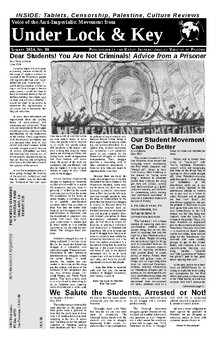
Whites Can Be Lumpen Too
I strongly disagree with the exclusion of whites from the ranks of the lumpen within the United $tates. (see the tenth paragraph of Wiawimawo’s article “Sakai’s Investigation of the Lumpen in Revolution” in ULK 64) Although most whites in the United $tates. enjoy “white privilege” there are also whole communities of disenfranchised, impoverished whites. These communities are heavily reliant on government support systems to survive (i.e. food stamps, SSI, welfare, section 8 housing, etc.) They are also rife with crime, drugs, and street gangs.
For example, take the lumpen organizations (L.O.s) from Chicago (i.e. the Gaylords and the Simon City Royals). Both of these organizations were started by disenfranchised, impoverished communities consisting of mostly whites. They were originally founded to protect their communities from outside forces.
By stating that only oppressed “minorities” can be considered lumpen, Wiawimawo is engaging in paternalist politics that causes divisions within the movement. The truth is that any people that fit the political, social, and economic profile are lumpen. Disenfranchisement is not unique, nor immune, to any nationality. In solidarity!
Wiawimawo of MIM(Prisons) responds: We are sending you a copy of “Who is the Lumpen in the United $tates?” so you can better understand our position on this question. First let’s look at the quote from my article that you are responding to:
“This is why, in our work on the First World lumpen in the United $tates, we excluded white people from the model by default. We did this despite knowing many white lumpen individuals who are comrades and don’t fit the model.”
Note i say that we know “many white lumpen individuals who are comrades,” meaning we agree with you that there are white lumpen, we just excluded them from the model presented in the paper cited. So why did we do this? Well, it is mostly based in our assessment of the principal contradiction in the United $tates being between the white oppressor nation and the oppressed nations. In the paper we do write:
“White men [who are currently/formerly incarcerated lumpen] number about 1.3 million, but are much more likely to find employment and join the labor aristocracy after release from prison. While in prison white men do fall into the lumpen class but lack the oppressed nation outlook and so often join white supremacist groups rather than supporting revolutionary organizing. This is just one factor contributing to a national outlook that leads us to exclude whites overall when discussing the revolutionary potential of the First World lumpen.”
We also point out that historically the settler nation made up of Europeans has always been a petty bourgeois nation, while the oppressed nations have histories that are largely proletarian, but also lumpen-proletarian. History affects our national and class consciousness, so we can’t just look at a snapshot in time. But the point of the paper was to show the size of the First World lumpen in the oppressed nations of the United $tates and a snapshot of how their conditions differ significantly from the white nation.
We’d say the examples you provide are exceptions that prove the rule. It takes some digging to come up with them, but certainly they exist. And in the context of the topic of this issue of Under Lock & Key we can certainly agree with you that they should not be ignored.
Most often, in U.$. prisons, when we talk about white L.O.s we are talking about white nationalist groups of some type. In our study, white supremacist organizations that are promoting fascism in this country today are made up of three main groups: former military, members of lumpen organizations/prisoners, and alienated petty bourgeois youth gathering around racist subcultures on the internet. The first two are the more dangerous groups, though the third gives the movement more of a feeling of a mass base of popularity. In our work it is with the second group that we can have the most impact. And we’ve had a number of former hardcore white supremacists become leaders within United Struggle from Within, and many more have participated in progressive battles for prisoner rights. It is in such alliances with the oppressed nations around the common interests of the imprisoned lumpen that we can really win over potential recruits who were initially drawn to fascism.
We welcome reports on examples of white lumpen organizing in the interests of ending oppression, and further analysis of the white lumpen as a base for progressive organizing.
Related Articles:This article referenced in:








